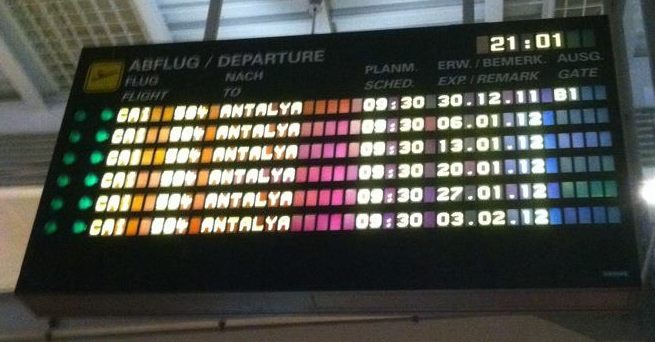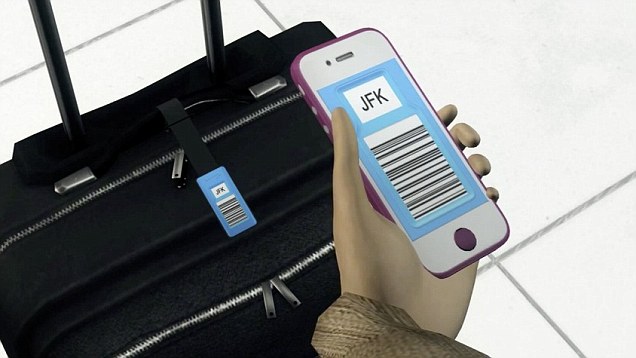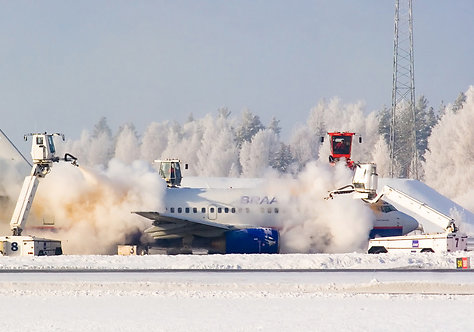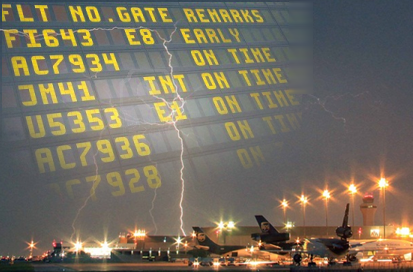
Returning from World ATM Congress in Barcelona (with the IHS Jane’s ATC Innovation Award in my baggage!), I think it’s time to address some feedback on an issue that I keep discussing in LinkedIn and elsewhere: The need to “link” the Airlines Operations Control Center (OCC) and the APOC (Airport Operations Center), the latter being a vital part in A-CDM.
Unfortunately, I see it happening frequently that these “control centers” live in their own little universe with little to no links to their peers. Talking about “Big Data”, Sabre as well as Amadeus and Travelport are “big data players”, though in danger to keep the silo thinking up too long.
Where Sabre once brought global e-Commerce to aviation, back in the 60s, back in the mid-80s, we installed the first Sabre Terminals in European travel agencies, aviation now stumbles behind on the possibilities of global e-Commerce, thanks mostly to technical limitations. As no-one wants to invest… If AA wouldn’t have invested at the time, where would we all be today? But is TPF (Transaction Processing Facility) still the core of our being? Or is it time to move on?
“When we are taught aviation at university we get the impression of how advanced aviation technology really is. When we start working, we are at awe, how little common sense or state-of-the-art is applied in aviation technologies.”
[a student at DLR German Aerospace Agency I recently talked to]
Today’s Agenda
Some keywords what I mean to address here are definitions such as A-CDM (vs. CDM) and Departure – or concepts like Collaboration or Rotation
What is the difference between an Airline Operations Control Center (OCC) and an Airport Operations Center (APOC)? And what about the Air Traffic Control’s Network Management Operations Center (NMOC)? And where is the “collaborative aspect” in these?
Right now, they are just three different data silos and collaboration, where it exists, is on a very small local level.
The OCC focuses to limit the negative impact any disruptions have on the operation of any single aircraft in the fleet. The OCC is – so far – the only point that has a rotational point of view, looking at the entire rotation of the aircraft and trying to minimize the impact of disruptions not just on the flight in question, but for all the ones following that particular “segment” (flight A to B).
 With increasing legal demand to reimburse passengers on late or canceled flights beyond the value of their net fare they paid, this is were money for the airline is burned. And impact of disruptions and delays at the airport or in the air space may be a nuisance for the work at the airport or the air traffic controllers, but they have a commercial impact on the airline:
With increasing legal demand to reimburse passengers on late or canceled flights beyond the value of their net fare they paid, this is were money for the airline is burned. And impact of disruptions and delays at the airport or in the air space may be a nuisance for the work at the airport or the air traffic controllers, but they have a commercial impact on the airline:
They are expensive.
Nevertheless, I seem to be rather alone in that point of view in discussions. Yes, there is an intellectual understanding at airports and ANSPs, but I have a gut-feeling, that it does not “compute” there really: Or why is it, that many ANSPs are not having their representative in the APOC? Not to talk about direct links yet. Or in the OCC? Or why do many APOCs not have direct (data) links to the OCCs of even their most important airlines?
What is … Departure Time?
 One discussion a few days ago addressed the definition of “departure”. And it is such a basic difference in definition, it hit me like a hammer, making me understand the impact of that different perception! When air traffic control talks about departure, they talk about the take-off of the aircraft (ATOT). When the airline and airports talk about the departure, they often talk about the time, the aircraft leaves it’s parking position at the terminal or on the apron, the off-block-time (AOBT). I had trouble, understanding, why an airport should invest into a “Pre-Departure Sequencer” instead of a DMAN in the delair-definition. The difference is based on the same subtle misperception of departure. The PDS and most “DMANs” out there focus on the TOBT, taking somewhat into account the delivery of the aircraft “in time” to the runway. Based on a rather “static” assumption of ATC capacity. The DMAN in delair perception optimizes the “real” departure. Taking into account minimum separation of aircraft, depending on the Standard Instrument Departure (SID) route and other highly complex parameters, the DMAN calculates the best TOBT. Thus, no matter the general disruptions at the airport and the real throughput on the runway by ATC, it delivers as many aircraft as possible for departure. That maximises the throughput and in turn minimizing the recovery time after general delays or disruptions.
One discussion a few days ago addressed the definition of “departure”. And it is such a basic difference in definition, it hit me like a hammer, making me understand the impact of that different perception! When air traffic control talks about departure, they talk about the take-off of the aircraft (ATOT). When the airline and airports talk about the departure, they often talk about the time, the aircraft leaves it’s parking position at the terminal or on the apron, the off-block-time (AOBT). I had trouble, understanding, why an airport should invest into a “Pre-Departure Sequencer” instead of a DMAN in the delair-definition. The difference is based on the same subtle misperception of departure. The PDS and most “DMANs” out there focus on the TOBT, taking somewhat into account the delivery of the aircraft “in time” to the runway. Based on a rather “static” assumption of ATC capacity. The DMAN in delair perception optimizes the “real” departure. Taking into account minimum separation of aircraft, depending on the Standard Instrument Departure (SID) route and other highly complex parameters, the DMAN calculates the best TOBT. Thus, no matter the general disruptions at the airport and the real throughput on the runway by ATC, it delivers as many aircraft as possible for departure. That maximises the throughput and in turn minimizing the recovery time after general delays or disruptions.
All that though happens at the given airport, i.e. Zürich. Talking with airports about departure management, the issue is about always that ATC (the ANSP) does not participate in the departure management, does not provide the needed information and – heresy! – how could we just imply that we could sort out the sequence for the air traffic controller? It works in Zurich? Heresy!
Is A-CDM not an FAA and Eurocontrol requirement? Burn it at the stake!
But now we go a step further…

The impact of the aircraft rotation and why A-CDM is something airlines should consider linking OCC to APOC, consider to spend time though the ANSPs who initiated the entire process are the ones stumbling behind their once shining visions of collaborative approaches:
Because the ANSP thinks in “Silo” and leg (flight from A to B).
A friend just recently told me about a major market, offering free access to the excellent flight-data for all flights within the region to the ANSP of a neighboring region, giving this to be offered in reverse to them. The neighboring ANSP (smaller) is not interested, the data is for sale. And they don’t see the additional value having access to the live flight data offered to them. Excuse me? That is Silo thinking.

And that is, why aviation technology today is way behind other industries. Because there is still silo-thinking. “Collaborative Decision Making” is a nice concept, but it fails real life on a large scale for the narrow-minded thinking of the people who’s job it would be to push the idea! It’s not about the bigger picture, but simply about own benefit. People call that “Greed” and it’s a mortal sin.
Food for Thought
Comments welcome
![“Our Heads Are Round so our Thoughts Can Change Direction” [Francis Picabia]](https://foodforthought.barthel.eu/wp-content/uploads/2021/10/Picabia-Francis-Round-Heads.jpg)
 New Airport Insider recently published a
New Airport Insider recently published a  Aside of Germany, France and a handful other nations, train is usually no issue. Within these countries, train is very competitive on the local market, especially the high speed trains like French TGV or German ICE. But now I go abroad. Into another country. I go into any travel agency, even in France or Germany and ask for international travel. Give me a guess: How often will they offer you train, even i.e. Paris-Frankfurt? All they intuitively look for in phase 1 is “flight”. Is the city the client wants to connect to bookable on the GDS (Global Travel Booking System)? If not, the agent (hopefully without showing you) rolls the eyes, curses you and starts looking up how the f*** to get you to that godforsaken town you ask for…
Aside of Germany, France and a handful other nations, train is usually no issue. Within these countries, train is very competitive on the local market, especially the high speed trains like French TGV or German ICE. But now I go abroad. Into another country. I go into any travel agency, even in France or Germany and ask for international travel. Give me a guess: How often will they offer you train, even i.e. Paris-Frankfurt? All they intuitively look for in phase 1 is “flight”. Is the city the client wants to connect to bookable on the GDS (Global Travel Booking System)? If not, the agent (hopefully without showing you) rolls the eyes, curses you and starts looking up how the f*** to get you to that godforsaken town you ask for…
 Likely, not knowing the language, maybe not even the local alphabeth, it’s going to be a taxi or a car from a large (global) rental car company offering navigation system. Or a personal pickup…
Likely, not knowing the language, maybe not even the local alphabeth, it’s going to be a taxi or a car from a large (global) rental car company offering navigation system. Or a personal pickup…






 My former
My former  And currently, the politicians of the “industry nations” miss to set the right tracks for the future. Would Moscow get the Russian corruption in check, no politicians would dare to challenge the authoritarian regime of this resource rich country. Just as they handle China with velvet gloves, knowing exactly that money rules the world and in the end, if they want to “profit” from the business, they dodge their high moral and ethics first… And aviation is simply a punching ball for them, screaming “noise” and “pollution”, no matter the major, largely unsubsidized developments in quieter and fuel efficient aircraft… Yeah, don’t think, just hit’em and milk’em!
And currently, the politicians of the “industry nations” miss to set the right tracks for the future. Would Moscow get the Russian corruption in check, no politicians would dare to challenge the authoritarian regime of this resource rich country. Just as they handle China with velvet gloves, knowing exactly that money rules the world and in the end, if they want to “profit” from the business, they dodge their high moral and ethics first… And aviation is simply a punching ball for them, screaming “noise” and “pollution”, no matter the major, largely unsubsidized developments in quieter and fuel efficient aircraft… Yeah, don’t think, just hit’em and milk’em!


 Just reading with great interest in
Just reading with great interest in 















 Researching on “heresy”, I sure stumbled over
Researching on “heresy”, I sure stumbled over 